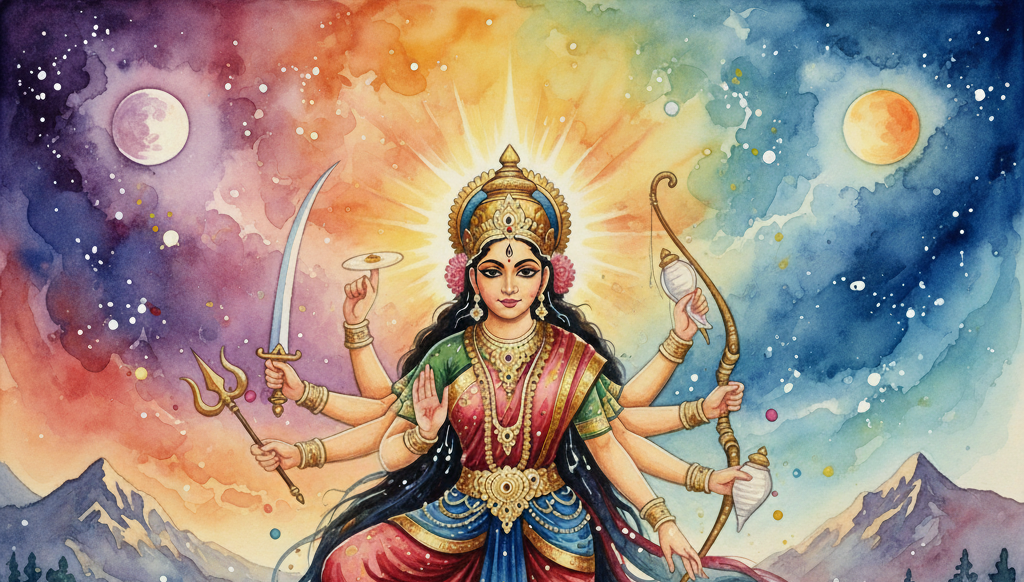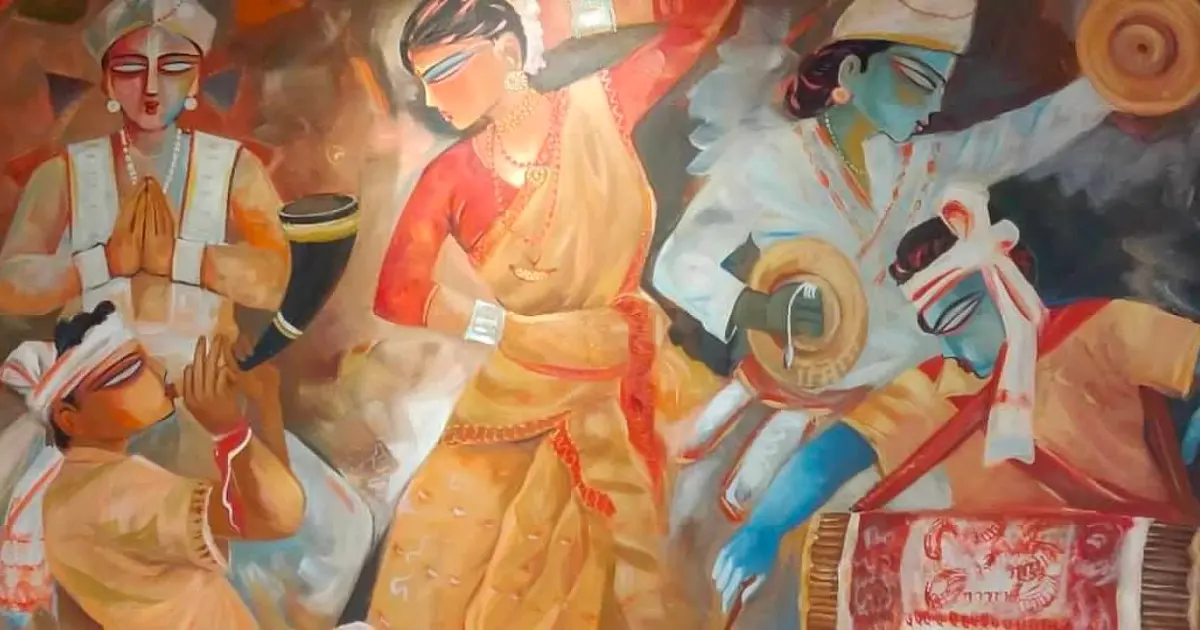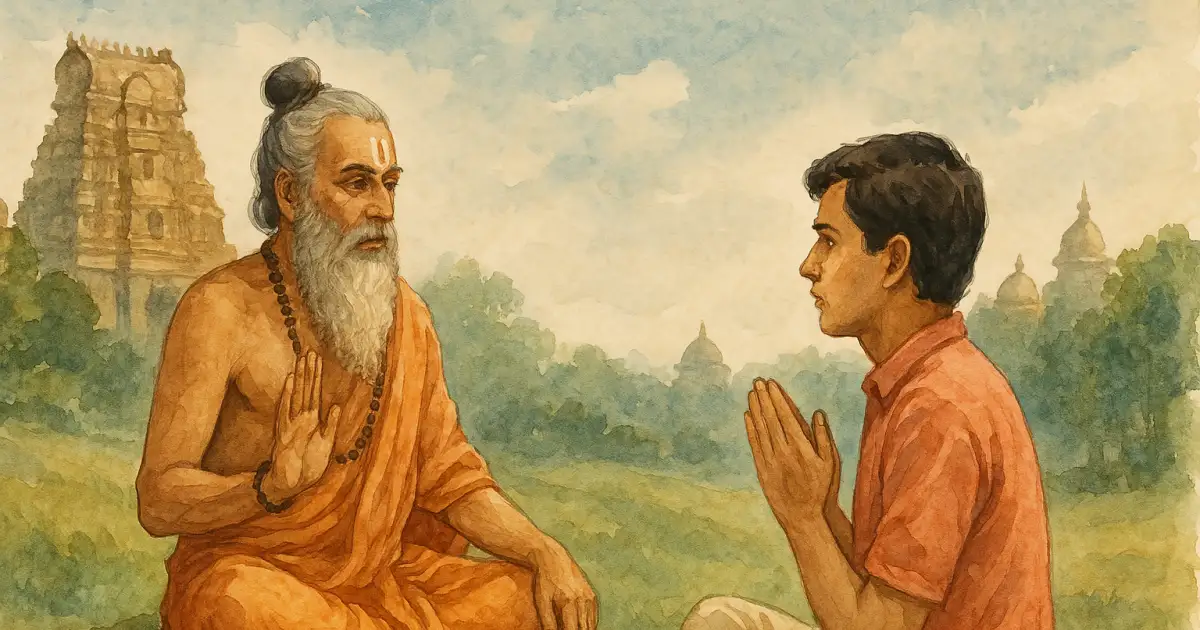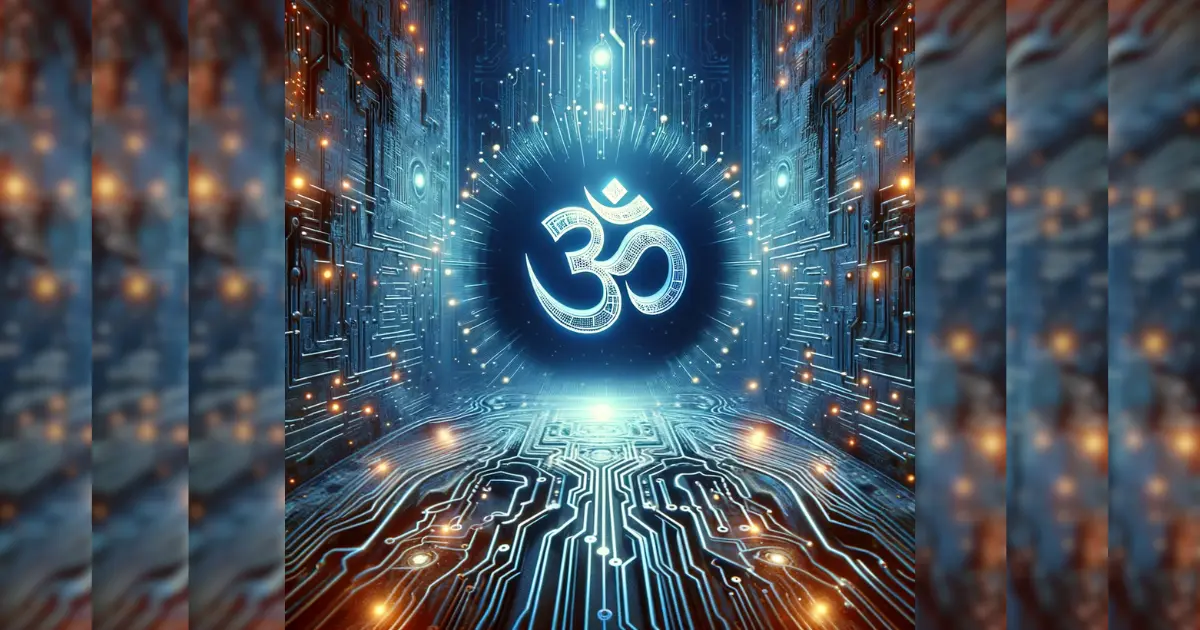Why only Nights?
The vaidika deity of the night is Rātri (or Niśā) (RV 10.127.1–8 – Rātri Sūkta), the daughter of the sky god Dyauḥ (father) and Pṛthvī (mother).
The night, comforts. Each one, whether human, plant, animal or insect, feels the urge to sleep at this time and forget about their troubles. The night sleep helps rejuvenate our entire body.
Merchants, traders or others who due to some compulsion would have to move or travel at night, prayed to her for protection from looters and wild animals.
Hence, Rātri Devī, comforts us like a mother, helps us rest while keeping a watchful eye, through the stars. The divine feminine energy that protects.
The Navarātrapradīpa (1928) by Vināyaka Paṇḍita Dharmādhikārī is a text based on the Dharmaśāstras, focusing on Navarātra rites, and makes a case for the worship of the Devī/Śakti at night for protection:
निशि भ्रमन्ति भूतानि शक्तयः शूलदृष्टयः ।
रात्रिरूपा यतो देवी दिवारूपो महेश्वरः ।
“Ghosts, having vision akin to the power of piercing spears, roam about in the night.
The Goddess is in the form of night; the Supreme Lord is in the form of day.”
The deities, therefore, have their designated roles and duties. While Sūrya deva performs his duty during the day, the Devīs take over at night and dawn (Uṣas devī).
Moreover, it is stated that the darkness of the night, or any kind of darkness for that matter, can only be dispelled by Devī’s luster.
We see this idea develop through the Purāṇas, where Rātri Devī takes the form of time, dissolution, and concealment. She is the full-fledged aspect of Śakti, fierce yet protective.
In the Mahābhārata, on the 14th night of the war, we see how the Kaurava army gets deluded and incurs tremendous losses because Devī, who is in charge of the night, stands with the righteous, as always.
So, during Navarātri worship, the emphasis on rātri (night) as the time of Devī’s pūjā carries vaidika memory: these nine nights are sacred, a time when Śakti is most accessible.
In paurāṇika cosmology:
• Rātri = dissolution, pralaya (cosmic night when the universe rests).
• She is linked to Yoganidrā of Viṣṇu, the divine sleep during which creation dissolves and re-manifests.
• Thus, Rātri becomes both cosmic rest (Śāntā) and cosmic terror (Raudrī).
The divine and protective power of Rātri Devī also helped the safe transportation of Lord Kṛṣṇa from Mathurā to Gokula after his birth. She is Yogamāyā, who can measure, delude, or manifest.
• Mahāmāyā → The deluding power that binds beings in saṃsāra.
• Yogamāyā → The liberating power that reveals bhagavān and facilitates bhakti.
• Both are aspects of the same Śakti (Devī), but with opposite orientations — one outward (bondage), the other inward (grace).
She is prakṛti through which the world and the entire cosmos come into their manifested form. She is the śakti that is the source of all creative and destructive forces. She even balances and maintains ṛta.
The Devī sūktam of the Ṛgveda and Devī māhātmyam of the Mārkandeya Purāṇa have the most beautiful descriptions of Śakti and so they are the texts that are read during Navarātri.
Do We Have Four or Five Navarātris?
Devī Bhāgavatam says:
चैत्रे अश्विने तथाऽषाढे माघे कार्यो महोत्सवः।
चतुर्षु नवरात्रेषु विशेषात् फलदायकः॥
In the months of Caitra, Āśvina, Āṣāḍha, and Māgha, this grand festival should be celebrated.
These four Navarātris are especially fruitful and auspicious.
Navarātri takes place four times a year, covering four seasons (all beginning with the respective month’s śukla pratipadā tithi):
Caitra/Vasanta Navarātri (March–April) – Spring – Lalitā worship
Āṣāḍha Gupta Navarātri (June–July) – Monsoon – Vārāhī worship
Śarad Navarātri (September–October) – Autumn – Caṇḍikā worship
Māgha Gupta Navarātri (January–February) – Winter – Rājmātaṅgī worship
A fifth, lesser-known Śākambharī Navarātri begins on pauṣa śukla aṣṭamī and ends on pauṣa pūrṇimā. Śākambharī Devī (a form of Devī Bhagavatī) is the goddess of vegetation and food, who appeared to end famine. Her worship is especially popular in Rajasthan, Karnataka (as Banashankari), and Maharashtra.
The Banashankari Devi Temple in Badami, North Karnataka, is dedicated to her and is a major pilgrimage site. The festival is widely celebrated across Karnataka, and many families have Vānaśaṅkarī as their kuladevatā (family deity).
The two gupta Navarātris are observed by initiates of the Śākta or Śrī Vidyā traditions.
The Transitional Seasons
शरत्काले विशेषेण कर्तव्यं विधिपूर्वकं।
वसंते च प्रकर्तव्यं तथैव भक्तिपूर्वकम्।
द्वावृतू यमदंष्ट्राख्यौ नूनं सर्वजनेषु वै॥
द्वावेव सुमहाघोरावृतू रोगकरौ नृणाम्।
वसंतशरदावेव जननाशकरावभौ॥ - Devī Bhāgavatam
In autumn, especially, duty is to be performed according to the rules.
And in spring, likewise, it is to be performed with devotion.
These two seasons are indeed called the fangs of Yama, truly for all people.
These two alone are extremely dreadful seasons, causing disease in humans.
Spring and autumn indeed appear as the destroyers of human life.
Explanation: Spring and autumn are ‘transition periods’ when seasons change, and therefore, illnesses and allergies are on the rise. Hence, one should pray for health and vigor/śakti.
Scriptural References
We have multiple references to the Navarātri vrata in our Purāṇas, like the Brahmavaivarta, Nārada, Kālikā Purāṇas, etc.
Importance of Saptamī, Aṣṭamī, and Navamī Tithi:
उपवासे ह्यशक्तानां नवरात्रव्रते पुनः।
उपोषणत्रयं प्रोक्तं यथोक्तं फलदं नृप॥
सप्तम्यां तथाऽष्टम्यां नवम्यां भक्ति भावतः।
त्रिरात्री करणात् सर्वं फलं भवति पूजनम्॥ - Devī Bhāgavatam
O King! For those unable to observe fasting during the Navarātri vow, it is prescribed to fast for three days, which yields the same fruit.
By worshipping with devotion on the seventh, eighth, and ninth days, the observance of these three nights grants the full merit of the entire vow.
Nakta Vrata (Night Vow)
अत्र देवीपूजैव प्रधानम् । उपवासादि त्वंगम् ।
तच्च पूजनं रात्रौ कार्यम् । “आश्विने मासि मेघान्ते महिषासुरमर्दिनीम् । निशाशु पूजयेद्भक्त्या सोपावासादिकः क्रमात्” इति देवीपुराणात् ॥
संग्रहेऽपि — आश्विने मासि मेघान्ते प्रतिपद्या तिथिर्भवेत् । तस्यां नक्तं प्रकुर्वीत रात्रौ देवीं च पूजयेत् ॥
रात्रिरूपा यतो देवी दिवारूपो महेश्वरः । रात्रिव्रतमिदं देवि सर्वपापप्रणाशनम् ॥
सर्वकामप्रदं नृणां सर्वशत्रुनिबर्हणम् । रात्रिव्रतमिदं तस्य रात्रौ कर्तव्यतेष्यते ॥
नक्तव्रतमिदं यस्मादन्यथा नरके गतिः ॥
इत्यादिवचनाश्च रात्रिव्रतत्वमेवाभिप्रेत्य माधवोक्तम् — “तस्य नक्तव्रतत्वादिति” ॥ न तु रात्रिभोजनात् ॥ - Devī Purāṇa
Here, worship of the Goddess is the foremost; fasting and related practices are considered its auxiliaries. And this worship must be performed at night.
As the Devī Purāṇa states:
“In the month of Āśvina, at the close of the rainy season, one should worship the slayer of Mahiṣāsura at night with devotion, following the order of fasting and related rites.”
Likewise, in the Saṅgraha, we see:
“In the month of Āśvina, at the close of the rains, when the pratipadā tithi arrives, one should undertake the night-fast (naktavrata) and worship the Goddess during the night.”
The Goddess is of the form of night, while Maheśvara is of the form of day. Therefore, this night-vow destroys all sins. It grants every desire to human beings and annihilates all enemies.
Hence, this vow is to be performed at night. If the naktavrata is not observed, one faces a fall into naraka.
On this basis, Mādhava has also affirmed that the intent is the observance of the night-vow (naktavrata), worship of the Goddess, not merely eating food at night.
Nārada Purāṇa
आश्विने शुक्लनवमी महापूर्वा प्रकीर्तिता ।। ११८-१७ ।।
अपराह्णे शमीपूजा कार्याऽस्यां प्राग्दिशि द्विज ।।
ततो निशायां प्राग्यामे खङ्गं धनुरिषून्गदाम् ।। ११८-१८ ।।
शूलं शक्तिं च परशुं धुरिकां चर्म खेटकम् ।।
छत्रं ध्वजं गजं चाश्व गोवृषं पुस्तकं तुलाम् ।। ११८-१९ ।।
दंडं पाशं चक्रशंखौ गंधाद्यैरुपचारकैः ।।
संपूज्य महिषं तत्र भद्रकाल्यै समालभेत् ।। ११८-२० ।।
The ninth day of the bright fortnight of Āśvina is celebrated as Mahānavamī.
On this day, the śamī tree should be worshipped in the afternoon, facing the east, O twice-born.
Then, at night, near the sacred fire, one must worship the weapons: sword, bow, arrows, and gadā (mace).
Also to be worshipped are the trident, spear, axe, club, shield, and buckler, together with the umbrella, banner, elephant, horse, cow, bull, book, and balance. Further, staff, noose, discus, and conch should be reverently worshipped with sandalwood and other offerings.
Having done so, one should symbolically invoke the buffalo and worship Bhadrakālī.
The three devatās — Mahāsarasvatī, Mahākālī, and Mahālakṣmī — represent Jñānaśakti, Icchāśakti, and Kriyāśakti (Caṇḍīsaptaśatī Mīmāṃsā by Potukūci Śrīrāmamūrtiḥ). These three forces are fundamental for the cosmos to function from the micro to the macro level.
The vyaṣṭi (collective) form of these three śaktis is called Caṇḍī. And that Caṇḍī is Parabrahman — also called Turīya-rūpa (the Śuddha-brahma rūpa).
The upāsanā of Devī is essential to ignite and sustain the three important Śaktis at the individual and societal levels.
Navarātri is Devī worship. The primordial regenerative and creative force, the power that drives each being from the cosmos to this world and the netherworlds — it is a time to celebrate that mūlaprakṛti, without which nothing exists. This primordial energy is channeled through worship in all its forms through these nine days.
Rituals
Devī worship is the common thread despite some variation in rituals across different states in Bhārata. We’ve mentioned prominent practices below:
o Main recitations and readings — Caṇḍī-pāṭha or Devī Māhātmya
o Ghaṭa/Kalaśa sthāpana representing Devī
o Kanyā Pūjā is also done — Girls who have not menstruated are seen and worshipped as representatives of Goddess Bālātripurasundarī.
o Saptamī is dedicated to Devī Sarasvatī, aṣṭamī to Devī Durgā, and navamī to Devī Lakṣmī.
o On saptamī, Mūla nakṣatra, Sarasvatī is invoked in the books and worshipped till navamī. During this time, study is prohibited and focus should be on worship.
o Āyudha Pūjā – worship of tools and weapons on navamī
o Kolu dolls are arranged on stepped platforms of odd numbers.
Pitṛ Pakṣa to Navarātri – From afterlife to this life – the cycle goes on:
The festivals of Bhārata, if seen from the beginning of the year to the end as per Hindu pañcāṅga, celebrate the seasons, energies, and cyclicity of time and nature.
Before pitṛ pakṣa, we see the visarjana of Lord Gaṇeśa, who is the deity of all auspiciousness, thus signaling the beginning of a somber period where auspicious tasks are not to be taken up.
Pitṛ pakṣa is a somber period, where families remember their departed ones, perform śrāddha, and maintain restraint.
Navarātri marks the transition from inward remembrance (ancestors) to outward invocation of śakti (cosmic energy for new beginnings).
Navarātri also brings a sudden catharsis and renewal — music, dance (Garba, Dandiya), colors, and collective joy. This contrast reflects the Hindu way of harmonizing saṃskāra (solemn remembrance) with utsava (celebration and renewal).
After pitṛ pakṣa reminds us of mortality (end of life), we enter Navarātri by invoking Devī to protect dharma and grant auspiciousness for the living.
Navarātri reminds us of śakti and continuity (the force that sustains and renews life). Together they embody the Hindu worldview: life and death are not opposites but cyclical — one flows into the other.
Guru Gobind Singh and Chhatrapati Śivājī Mahārāja – Great Devī upāsakas:
All weapons are representations of the Devī/Śakti, and thus considered feminine. They are used to fight/kill and at the same time, protect. That is why weapons and tools are worshipped during Navarātri as one of the forms of Devī/Śakti.
The sword of Guru Gobind Singh was Devī Caṇḍī’s gift and so was named ‘Caṇḍī’ (as mentioned in Caṇḍī dī vār written by Guru Gobind Singh ji).
Chhatrapati Śivājī Mahārāja’s sword was named Bhavānī. It was gifted to him by Devī Bhavānī, who was pleased with his devotion to her.
Kālīdāsa became the greatest poet of all time with incessant devotion to Mā Kālī. She can destroy tamas, generate satva, and even rajas in devotees, and vice versa for the evil ones.
Conclusion
Navarātri is more than a festival; it is a cosmic remembrance. Across Vedas, Purāṇas, and lived practice, night and the Goddess are intertwined. Rātri is shelter and dissolution, Yogamāyā and Mahāmāyā are protector and revealer.
To worship Devī in Navarātri is to honor the primal mūlaprakṛti, the source of all creation and destruction, the balance of ṛta itself. Without her, nothing exists. With her, the cosmos is sustained.
Whether one celebrates through fasting, dance, or reciting scriptures, the heart of Navarātri lies in recognizing the goddess as the primal energy from which everything arises, by which it is sustained, and into which it dissolves.
The three forms of Mahāsarasvatī, Mahākālī, and Mahālakṣmī represent knowledge, will, and action — forces fundamental at both cosmic and individual levels. Their collective form, Caṇḍī, is none other than the supreme Brahman in feminine form.
Navarātri is not just a festival of nine nights. These nine nights remind us: all power is Hers, and to remember Her is to align with the eternal pulse of life.
It is a meditation on the pulse of existence itself: remembrance and renewal, concealment and revelation, dissolution and creation. To worship Devī in these nine nights is to align oneself with the rhythm of the cosmos, recognizing that all power is Hers, and through Her, all life is sustained.
Note:
Bṛhat Dhīti, has curated several articles dedicated to Devī.
Please check them out here.
References
-
https://www.wisdomlib.org/hinduism/book/rig-veda-english-translation/d/doc840060.html
-
https://archive.org/details/wg339/page/n5/mode/2up
-
https://archive.org/details/devi-bhagavata-with-hindi-translation/Devi%20Bhagavata%20with%20Hindi%20Translation%20Vol%201%20%28Gitapress%29%202010/
-
https://www.drikpanchang.com/navratri/shakambari/banada-ashtami-date-time.html
-
https://archive.org/details/naradapuranaeng041952ocrmotilalbanasirdass
-
https://www.youtube.com/watch?v=grhK5oiGC6U
-
https://www.youtube.com/watch?v=yi1CYs--bkA
- https://www.amazon.in/NAVARATRI-WHEN-DEVI-COMES-HOME/dp/9355200455







